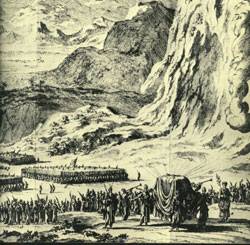

|
|
| Musical Musings: Liturgy |
Wandering in the DesertAfter forty years, we still seek the musical Promised Landby Anthony Corvaia, JrThis article, which appeared in the February 2007 online edition of Adoremus Bulletin, is reprinted with the kind permission of the editor, Helen Hull Hitchcock.
"The musical tradition of the universal Church is a treasure of inestimable value, greater even than that of any other art. The main reason for this pre-eminence is that, as sacred song united to the words, it forms a necessary or integral part of the solemn liturgy... Therefore sacred music is to be considered the more holy in proportion as it is more closely connected with the liturgical action, whether it adds delight to prayer, fosters unity of minds, or confers greater solemnity upon the sacred rites." [Sacrosanctum concilium 112] In the days before Vatican II, the average parish music program was fairly simple. The volunteer choir, always lacking in tenors it seems, knew a few accompanied Masses and some motets from the Saint Gregory Hymnal or from a handful of similar sources. Parishes with sophisticated pastors had organists who could play with both feet and trained choir directors who attempted the occasional Palestrina or Victoria piece, or compositions from contemporary composers like Montani, Perosi, Yon and Ravanello. A short list of Latin and vernacular hymns supplied music for low Mass and devotions. The motu proprios of several popes along with the Caecilian Movement had reined in the excesses of the Baroque and Classical styles and urged choir directors to rediscover the Church's musical patrimony of chant and polyphony, which were raised up as models for new compositions. The liturgical renewal of the first half of the 20th century saw progressive parishes adopt congregational chant Masses, typically the Mass of the Angels, and dialogue Masses. Music in the Roman Rite was on a steady course. Then along came Vatican II and the direction changed. While continuing to cite chant and polyphony as the ideal, the Council encouraged congregational singing [SC 30] and permitted the use of the vernacular [SC 36.2,3], thus allowing a much broader repertoire. The prospects were exhilarating. Of course there were some who, like the mythological Cassandra, sounded warnings that were not taken seriously, who saw in the new freedom the fulfillment of the maxim: "Every innovation occasions more harm and derangement of order by its novelty, than benefit by its abstract utility." But the excitement of a new vision for liturgical music swept all nay-sayers away. In the vast majority of parishes the vision remained a dream, however. Pastors who could hardly afford the organist-choir director at the one Sunday Mass with music were now faced with the need for an organist and cantor for the plethora of weekend Masses. Guitars and amateur songsters became a cheap alternative. Hymnals, never a low-cost commodity, would have to be bought. Instead, the urgent need for musical resources was filled with text-only song sheets and woefully inadequate "Mass books" consisting mostly of warmed-over Protestant hymns and campfire songs. Because "active participation" was the cry of the day, the act of singing was emphasized over what was being sung. With congregational participation a priority, choirs were left to languish and expire. In line with the anti-authoritarian spirit of the times, the opinions and contributions of the amateur were valued more than the expertise and experience of the professional musician, who symbolized the supposedly patriarchal and oppressive pre-Vatican II Church. Those musicians who had spent many years in the service of the Church at substandard wages (if they were paid at all) became increasingly unhappy at having to dish up the pabulum required by musically uninformed pastors and obdurate liturgy committees, who were either unfamiliar with the Council's documents or hoodwinked by the purveyors of the new music. 
After forty years of wandering in the desert, we still have not found the musical Promised Land. In too many places we now have well-intentioned but ill-prepared "music ministers" who have no knowledge of liturgical music before 1965 and therefore no appreciation for the vast musical heritage of the Western Church. Their repertoire is determined largely by music publishers whose musical selections, like the "missalettes" that propagate them, are totally disposable, frustrating any hope of a consistent Catholic repertoire. The texts are often influenced more by popular social theory than by Scripture and theology. Except for the contribution of a small handful of classically trained liturgical composers, after a half century the most this generation has been able to add to the Church's musical treasury has been some lightweight music that can be performed by amateur musicians and ad-hoc singers. There are some parishes that sponsor music programs of liturgical, musical and pastoral excellence, but they are the exception. Some fall victim to shrinking parish budgets. Some simply wither because there is not enough qualified and interested talent to lead them. Others are constrained by parish liturgy committees. Increasingly, parish music programs are governed by ideologies and assumptions rather than by the documents and authentic spirit of Vatican II. Some of the misconceptions about what constitutes legitimate practice have become codified into a kind of "liturgical correctness" that dare not be questioned. It's time to dispel some of these misconceptions. |